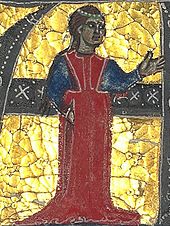Castelloza

Na
Life

According to her later
Career
As a trobairitz, Castelloza was responsible for producing poems and Cantigas (monophonic songs) throughout her career. Her works (primarily written in Galician-Portuguese) maintain the characteristics of the Canso, often referencing themes of love and courtship. The canso was a popular style among troubadours, often describing a male speaker pining after a ‘cruel female beloved.’ Castelloza continues this song structure from her perspective, expressing the challenges and conflict she, as a woman, faces. “In each of her songs, Na Castelloza takes up a posture that is simultaneously offensive and defensive: she regularly signals and defends her anomalous role as a woman who declares and serves her love by singing.”[3] This is apparent throughout her work; an example being ‘Mout avetz fach lonc estatge…’ (To Her Lover Gone Away). An excerpt translation of this poem highlights the following;
“My handsome noble-natured dear, I’ve loved you since the day you pleased me. How great a fool I am is clear. For you held back, while such love seized me That I not once have turned away. Though you repay my good with ill I’ll stand my ground and love you still, For love so has me in its sway That I now doubt my life can offer.”[4]
Castelloza maintains this perspective throughout her lasting work, describing the pain and betrayal of unrequited love while acknowledging her commitment to absolute fidelity.
Only three—perhaps four if recent scholarship is accepted—of her songs (all
Compared with Beatriz de Dia, Castelloza is a more conservative poet. Her persona throughout her works is consistent and though she raises the tension between conditional and unconditional love she always remains committed to absolute fidelity.[7]
One scholar, Peter Dronke, has seen Castelloza's songs as forming a lyric cycle.[8]
List of works
- Ja de chantar non degra aver talan
- Amics, s'ie.us trobes avinen
- Mout avetz faich lonc estatge
- Per joi que d'amor m'avegna (disputed)
References
Notes
Citations
- ^ a b c d Vidas, p. 26.
- JSTOR 44943223. Retrieved 5 May 2023.
- JSTOR 43802003. Retrieved 5 May 2023.
- ^ Foreman, A.Z. "Lady Castellosa: To Her Lover Gone Away (From Occitan)". Poems Found in Translation. Retrieved 5 May 2023.
- ^ Coldwell, "Castelloza".
- ^ Bruckner, 871.
- ^ Bruckner, 877.
- ^ Bruckner, 884.
Bibliography
- Bruckner, Matilda Tomaryn (1992). "Fictions of the Female Voice: The Women Troubadours". Speculum. 67 (4): 865–891. ISSN 0038-7134.
- ISBN 978-1-56159-239-5.
- Egan, Margarita, ed. (1984). The Vidas of The Troubadours. Garland Library of Medieval Literature. Vol. 6. New York and London: ISBN 9780824094379.
Further reading
- Gravdal, Kathryn. "Mimicry, Metonymy, and 'Women's Song': the Medieval Women Trobairitz." Romanic Review, 83:4 (1992:Nov.) pp. 411–427.
- Paden, William D., Jr. "The Poems of the 'Trobairitz' Na Castelloza." Romance Philology, 35:1 (1981:Aug.), pp. 158–182.
- Schutz, A. H. "Where Were the Provençal 'Vidas' and 'Razos' Written?" Modern Philology, Vol. 35, No. 3. (Feb., 1938), pp. 225–232.
- Shapiro, Marianne. "The Provençal Trobairitz and the Limits of Courtly Love." Signs, Vol. 3, No. 3. (Spring, 1978), pp. 560–571.
- Weiss, Julian. "Lyric Sequences in the Cantigas d'amigo." Bulletin of Hispanic Studies, 65:1 (1988:Jan.), pp. 21–38.
- Bec, Pierre. « L’Amour au Féminin: Les Femmes-Troubadours et Leurs Chansons » (2013, fédérop).
